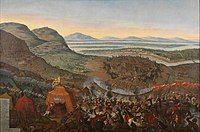Mehmed IV
Template:Infobox Ottoman sultan
Mehmed IV Modern Turkish Mehmet (Ottoman Turkish: محمد رابع Meḥmed-i rābi‘; also known as Avcı Mehmed, Mehmed the Hunter; January 2, 1642 – January 6, 1693) was the Sultan of the Ottoman Empire from 1648 to 1687. Taking the throne at age six, his reign was significant as he changed the nature of the Sultan's position forever by giving up most of his executive power to his Grand Vizier.
Biography
Early life
Born at Topkapı Palace, Constantinople, in 1642, he was the son of Sultan Ibrahim (1615–48) by Valide Sultan Turhan Hatice, a Ruthenian (Ukrainian) concubine,[1] and the grandson of Kösem Sultan of Greek origin.[2][3][4][5] Soon after his birth, his father and mother quarreled, and Ibrahim was so enraged that he tore Mehmed from his mother's arms and flung the infant into a cistern. Fortunately, Mehmed was rescued by the harem servants. His father's actions resulted in Mehmed cutting his head, which left him with a lifelong scar.[6]
Reign
Mehmed ascended to the throne in 1648 at the age of only six. His ascension marked the end of a very volatile time for the Ottoman Dynasty; there had been a Mustafa I deposed twice and two Sultans killed, including Mehmed’s father and predecessor, Ibrahim.
Accomplishments

Sultan Mehmed IV was known as Avcı, "the hunter", as this outdoor exercise took up much of his time.
His reign is notable for a brief revival of Ottoman fortunes led by the Grand Vizier Mehmed Köprülü and his son Fazıl Ahmet. They regained the Aegean islands from Venice, and Crete, during the Cretan War (1645–1669). They also fought successful campaigns against Transylvania (1664) and Poland (1670–1674). At one point, when Mehmed IV allied himself with Petro Doroshenko, Ottoman rule was close to extending into Podolia and Ukraine. See Reply of the Zaporozhian Cossacks for his correspondence with the Cossacks.
A later vizier, Kara Mustafa was less able. Supporting the 1683 Hungarian uprising of Imre Thököly against Austrian rule, Kara Mustafa marched a vast army through Hungary and besieged Vienna at the Battle of Vienna. On the Kahlenberg Heights, the Ottomans suffered a catastrophic rout by Polish forces famously led by their King, John III Sobieski (1674–96), and his Holy League allies, notably the Imperial army.

This section is empty. You can help by adding to it. (January 2014) |



But on September 12, 1683, the Austrians and their Polish allies under King Jan Sobieski took advantage of dissent within the Turkish military command and poor disposition of his troops, winning the Battle of Vienna with a devastating flank attack led by Sobieski's Polish cavalry. The Turks retreated into Hungary, however this was only the beginning of the Great Ottoman War as the armies of the Holy League began their long, but successful campaign to push back the ottomans to the Balkans.
Later life and death
In 1687 he was deposed by the combined forces of Yeğen Osman and the janissaries. Mehmed then was imprisoned in Topkapı Palace. However, he was permitted to leave the Palace from time to time, as he died in Edirne Palace in 1693. He was buried in Turhan Hadice Sultan's tomb, near his mother's mosque in Constantinople. Just before he died in 1691, a plot was discovered in which the senior clerics of the empire planned to reinstate Mehmed on the throne in response to the ill health of his successor, Suleiman II.
His favourite harem girl was Emetullah Rabia Gülnûş Sultan, who was a slave girl and his later wife taken prisoner at Rethymnon (Turkish Resmo) in the island of Crete.[7] Their two sons, Mustafa II and Ahmed III, became Ottoman Sultans during (1695–1703) and (1703–1730) respectively.
Purported exchange with Cossacks
An incident during Mehmed IV's reign is remembered mainly in Ukraine and Russia. The Zaporozhian Cossacks defeated Ottoman forces in the field and refused the Sultan's demand to submit, answering him with a letter full of insults and profanities. This response is commemorated in the famous late 19th-century painting Reply of the Zaporozhian Cossacks by the Russian painter Ilya Repin.
The Quaker Mary Fisher
In 1658 Mehmed IV received and patiently listened to the English Quaker preacher Mary Fisher, who believed she was sent by God to speak to him. The meeting is known mainly from Fisher's own very favorable account (see Mary Fisher) rather than from Ottoman sources, so that it is not known precisely what the Sultan made of her message (which was relayed to him in translation).
See also
Notes
- ^ Natalia Yakovenko."Essays on History on Ukraine. From the Earliest Times until the End of the 18th Century". 1997.
- ^ E. van Donzel, Islamic Desk Reference: Compiled from the Encyclopaedia of Islam, Brill Academic Publishers, p 219
- ^ Robert Bator, Daily Life in Ancient and Modern Istanbul, Runestone Press, p 42
- ^ Douglas Arthur Howard, The History of Turkey, Greenwood Press, p 195
- ^ Kosem Sultan - Britannica Online Encyclopedia
- ^ John Freely - Inside the Seraglio published 1999, Chapter 9: Three Mad Sultans
- ^ Some sources state that she was originally an ethnic Greek named Evmania while others state that she was of Venetian Verzini family settled in Crete.
